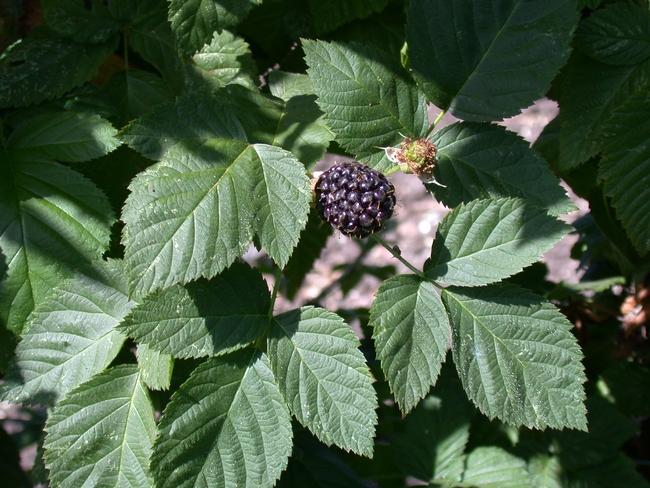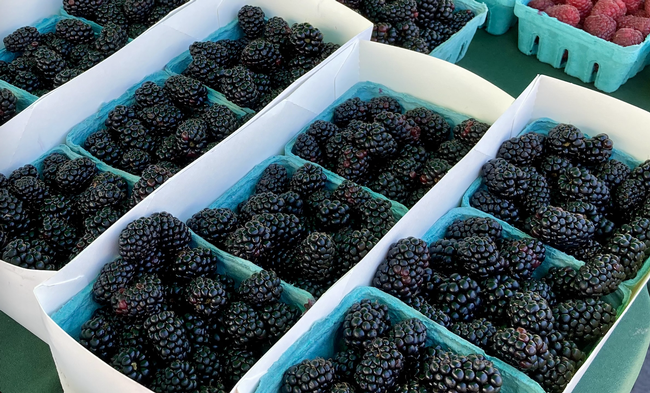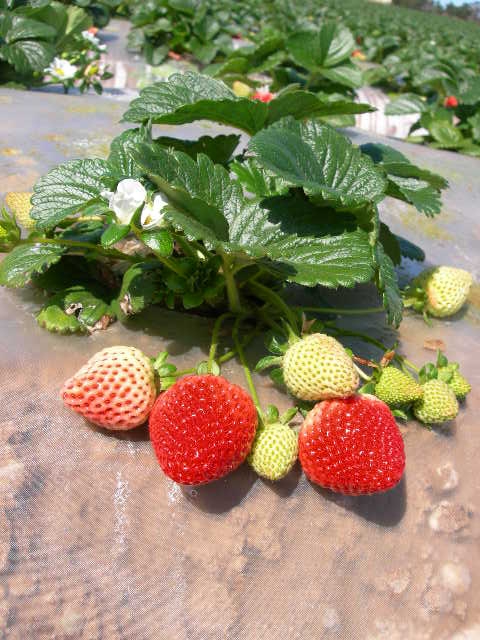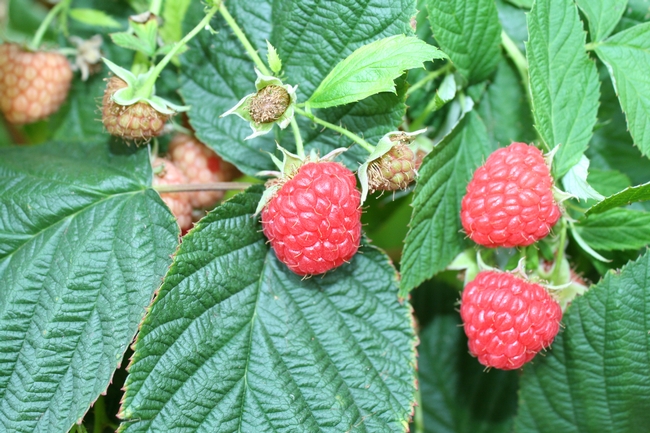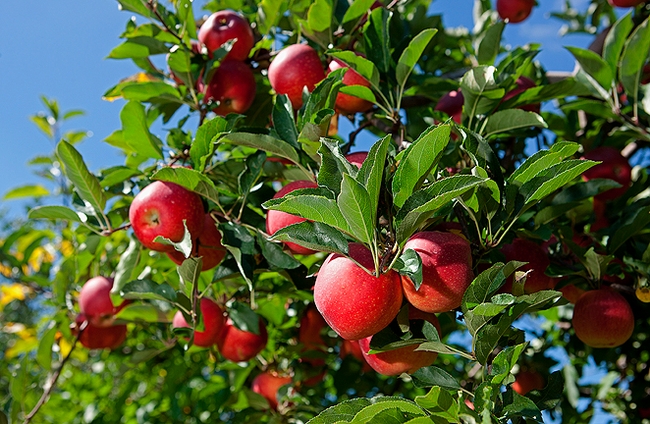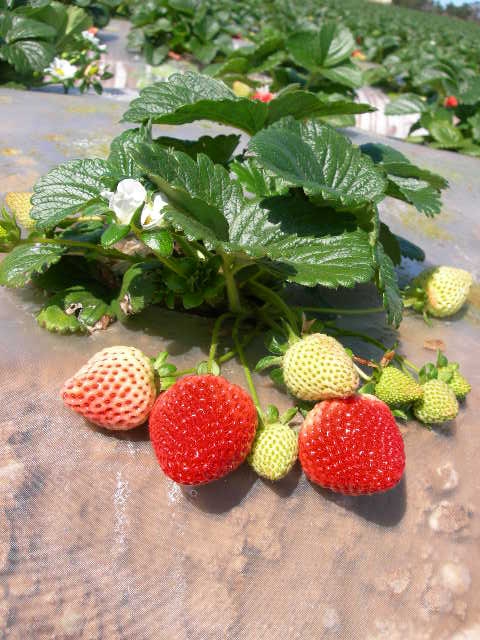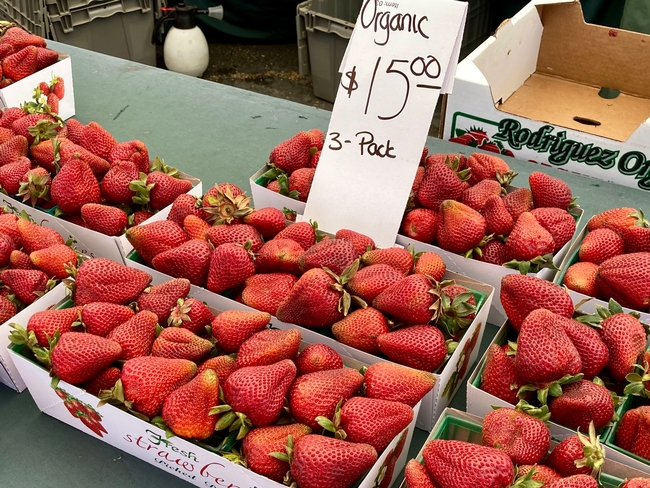Posts Tagged: Mark Bolda
New UC study estimates blackberry production costs
A new study that can help growers and other readers estimate costs and potential returns for blackberries grown on California's Central Coast was recently released by UC Agriculture and Natural Resources, UC Cooperative Extension and the UC Davis Department of Agricultural and Resource Economics.
“The study provides growers with a baseline to estimate their own costs, which can help when applying for production loans, projecting labor costs, securing market arrangements or understanding costs associated with water and nutrient management and regulatory programs,” said Brittney Goodrich, UC Cooperative Extension specialist and study co-author.
The cost study models a management scenario for a 30-acre farm, 15 acres of which are planted to blackberries. The remaining acres are planted to other berries or are used for the irrigation system, roads and buildings. The authors describe the cultural practices used for the establishment, production and harvest of blackberries, including land preparation, soil fertility and pest management, irrigation and labor needs.
The 28-page study shows costs for each operation, material inputs and costs, and cash and non-cash overhead costs in a variety of formats for an establishment year and then four additional production years. A ranging analysis for the four production years is also included and shows potential profits or losses over a range of prices and yields.
The new study, titled “2024 Sample Costs to Establish, Produce and Harvest Blackberries” can be downloaded from the UC Davis Department of Agricultural and Resource Economics website at https://coststudies.ucdavis.edu.
For a detailed explanation of the assumptions and calculations used to estimate the costs and potential returns, readers can refer to the narrative portion of the study.
Sample cost of production studies for many other commodities grown in California are also available on the website.
For more information, contact Mark Bolda, University of California Cooperative Extension farm advisor, at mpbolda@ucanr.edu or Jeremy Murdock in the UC Davis Department of Agricultural and Resource Economics at jmmurdock@ucdavis.edu.
New UC study estimates costs for growing strawberries on the Central Coast
A new study that can help growers and other readers estimate costs and potential returns for growing strawberries on California's Central Coast was recently released by UC Agriculture and Natural Resources, UC Cooperative Extension and the UC Davis Department of Agricultural and Resource Economics.
“This study provides growers with a baseline to estimate their own costs, which can help when applying for production loans, projecting labor costs, securing market arrangements, or understanding costs associated with water and nutrient management and regulatory programs,” said Brittney Goodrich, UC Cooperative Extension specialist and study co-author.
The cost study models a management scenario for a 50-acre farm, 45 acres of which are planted to strawberries, located in Santa Cruz, Monterey or San Benito counties. The remaining acres are for the irrigation system, roads and buildings. The study describes the cultural practices used in strawberry production and harvest, including land preparation, soil fertility and pest management, irrigation and labor needs.
The 19-page study shows costs for each operation, material inputs and costs, and cash and non-cash overhead costs in a variety of formats for one production and harvest cycle. A ranging analysis is also included and shows potential profits or losses over a range of prices and yields.
The new study, titled “2024 Sample Costs to Produce and Harvest Strawberries” can be downloaded from the UC Davis Department of Agricultural and Resource Economics website at https://coststudies.ucdavis.edu.
For a detailed explanation of the assumptions and calculations used to estimate the costs and potential returns for each crop, readers can refer to the narrative portion of each study.
For more information, contact Mark Bolda, University of California Cooperative Extension farm advisor, at mpbolda@ucanr.edu, or Jeremy Murdock in the Department of Agricultural and Resource Economics at jmmurdock@ucdavis.edu.
Sample cost of production studies for many other commodities grown in California are also available at https://coststudies.ucdavis.edu.
New UC study estimates raspberry production costs on Central Coast
A new study that estimates costs and potential returns for growing raspberries on the Central Coast is available for free from UC Agriculture and Natural Resources, UC Cooperative Extension and the UC Davis Department of Agricultural and Resource Economics.
“These studies provide growers with a baseline to estimate their own costs, which can help when applying for production loans, projecting labor costs, securing market arrangements, or understanding costs associated with water and nutrient management and regulatory programs,” said Brittney Goodrich, UC Cooperative Extension specialist and study co-author.
The UC Cooperative Extension study focuses on raspberries grown in Santa Cruz, Monterey and San Benito counties for the fresh market.
The cost study models a management scenario for a 45-acre farm, 42 acres of which are planted to raspberries. The remaining acres are for the irrigation system, roads and buildings. Each study describes the cultural practices used for establishing, producing and harvesting raspberries, including land preparation, soil fertility and pest management, irrigation and labor needs.
The 36-page study shows costs for each operation, material inputs and costs, and cash and non-cash overhead costs in a variety of formats for three production years. A ranging analysis for each production year is also included and shows potential profits or losses over a range of prices and yields. The authors also note California's 2023 minimum wage and overtime rules.
The new study, “2023 Sample Costs to Produce and Harvest Raspberries,” can be downloaded from the UC Davis Department of Agricultural and Resource Economics website at https://coststudies.ucdavis.edu.
For a detailed explanation of the assumptions and calculations used to estimate the costs and potential returns for each crop, readers can refer to the narrative portion of the study.
For more information, contact Mark Bolda, University of California Cooperative Extension farm advisor, at mpbolda@ucanr.edu, Laura Tourte, emeritus UC Cooperative Extension farm advisor, at ljtourte@ucanr.edu, or Jeremy Murdock in the Department of Agricultural and Resource Economics at jmmurdock@ucdavis.edu.
Sample cost of production studies for many other commodities grown in California are also available for free at https://coststudies.ucdavis.edu.
New UC studies estimate production and harvest costs for coastal apples
Two new studies that can help Central Coast growers and other readers estimate costs and potential returns for both organically and conventionally produced apples for processing were recently released by University of California Agriculture and Natural Resources, UC Cooperative Extension and the UC Davis Department of Agricultural and Resource Economics.
“These studies provide growers with a baseline to estimate their own costs, which can help when applying for production loans, projecting labor costs, securing market arrangements, or understanding costs associated with water and nutrient management and regulatory programs,” said Brittney Goodrich, UC Cooperative Extension specialist and co-author of the studies.
The new studies, “2023 Sample Costs to Produce and Harvest Organic Apples for Processing” and “2023 Sample Costs to Produce and Harvest Apples for Processing,” can be downloaded for free from the UC Davis Department of Agricultural and Resource Economics website at https://coststudies.ucdavis.edu.
The studies focus on processing apples, not fresh market apples, which makes a difference in farming practices. Apples grown for processing on the Central Coast are mostly pressed for juice and sparkling cider.
“Ready-to-eat means that looks matter – blemishes and so forth are a big deal. Juice not so much, it all gets smushed in the end,” said co-author Mark Bolda, UC Cooperative Extension farm advisor for Santa Cruz, Monterey and San Benito counties. “Varieties grown here are Gala, Newtown Pippins, Mitsui and some Granny Smith.”
The cost studies model a management scenario for a 100-acre farm, 20 acres of which are planted to a mature orchard that produces apples for processing. The remaining acres are planted to apples not yet in production, caneberries, strawberries and vegetables. In each study, the authors describe the cultural practices used for organically or conventionally produced apples, including land preparation, soil fertility and pest management, irrigation and labor needs. Harvest costs are also shown.
In six tables, they show the individual costs of each operation for apples, material input costs, and cash and non-cash overhead costs in a variety of formats. A ranging analysis shows potential profits over a range of prices and yields.
For a detailed explanation of the assumptions and calculations used to estimate the costs and potential returns for each crop, readers can refer to the narrative portion of each study.
For more information, contact Mark Bolda at mpbolda@ucanr.edu; Laura Tourte, emeritus UCCE advisor, at ljtourte@ucanr.edu; or Jeremy Murdock of UC Davis Department of Agricultural and Resource Economics at jmmurdock@ucdavis.edu.
Sample cost of production studies for many other commodities grown in California are also available for free at https://coststudies.ucdavis.edu
UC study breaks down costs of growing organic strawberries
Thinking about commercially growing organic strawberries on the Central Coast?
To help prospective and current growers evaluate financial feasibility, the University of California has estimated costs to produce and harvest organic strawberries for fresh market in Santa Cruz, San Benito and Monterey counties.
“This revise of the last cost-of-production study incorporates the newest in labor costs along with updates on cultural techniques,” said study co-author Mark Bolda, UC Cooperative Extension strawberries and caneberries advisor in Santa Cruz, San Benito and Monterey counties.
The new study, “Sample Costs to Produce and Harvest Organic Strawberries in the Central Coast Region-2022,” has been released by UC Agriculture and Natural Resources and UC Davis Department of Agricultural and Resource Economics.
The analysis is based on a hypothetical well-managed organic strawberry farm using practices common to the region, but the costs, materials and practices shown in this study will not apply to all farms. Growers, UC Cooperative Extension farm advisors and specialists, pest control advisers and others provided input and reviewed the methods and findings of the study.
“Current growers can use it as a baseline to compare with their own cost and returns estimates to make sure they have an accurate picture of the profitability of their organic strawberry enterprise,” said co-author Brittney Goodrich, UC Cooperative Extension agricultural economics specialist. “Many agricultural lenders use these studies as a baseline to determine whether to approve operating or investment loan requests from current and potential strawberry growers.”
The researchers assume a farm operation size of 30 contiguous acres of rented land, with strawberries are planted on 27 acres. The study includes a list of suitable strawberry varieties for the region, but no specific variety is used in the study. The crop is harvested by hand and packed into trays containing eight 1-pound clamshells from April through early October, with peak harvest in June through August.
The authors describe the assumptions used to identify current costs for production material inputs and cash and non-cash overhead. Ranging analysis tables show net profits over a range of prices and yields. Other tables show the monthly cash costs, the costs and returns per acre, hourly equipment costs, and the whole farm annual equipment, investment and business overhead costs.
The study's expanded section on labor includes information on California's new minimum wage and overtime laws.
“It's reached a wider audience this time through presentations of the material to students at Cal Poly [San Luis Obispo] and also a group of USDA officials at the California Strawberry Commission,” said Bolda.
“All of this just underlines the value of these studies to California growers and others working in agriculture,” Bolda said.
Free copies of this study and other sample cost of production studies for many commodities are available. To download the cost studies, visit the UC Davis Department of Agricultural and Resource Economics website at https://coststudies.ucdavis.edu.
This cost and returns study was funded by the UC Davis Department of Agricultural and Resource Economics.
For additional information or an explanation of the calculations used in the studies, contact Jeremy Murdock, UC Davis Department of Agricultural and Resource Economics, at jmmurdock@ucdavis.edu or UC Cooperative Extension's Bolda at (831) 763-8025.


